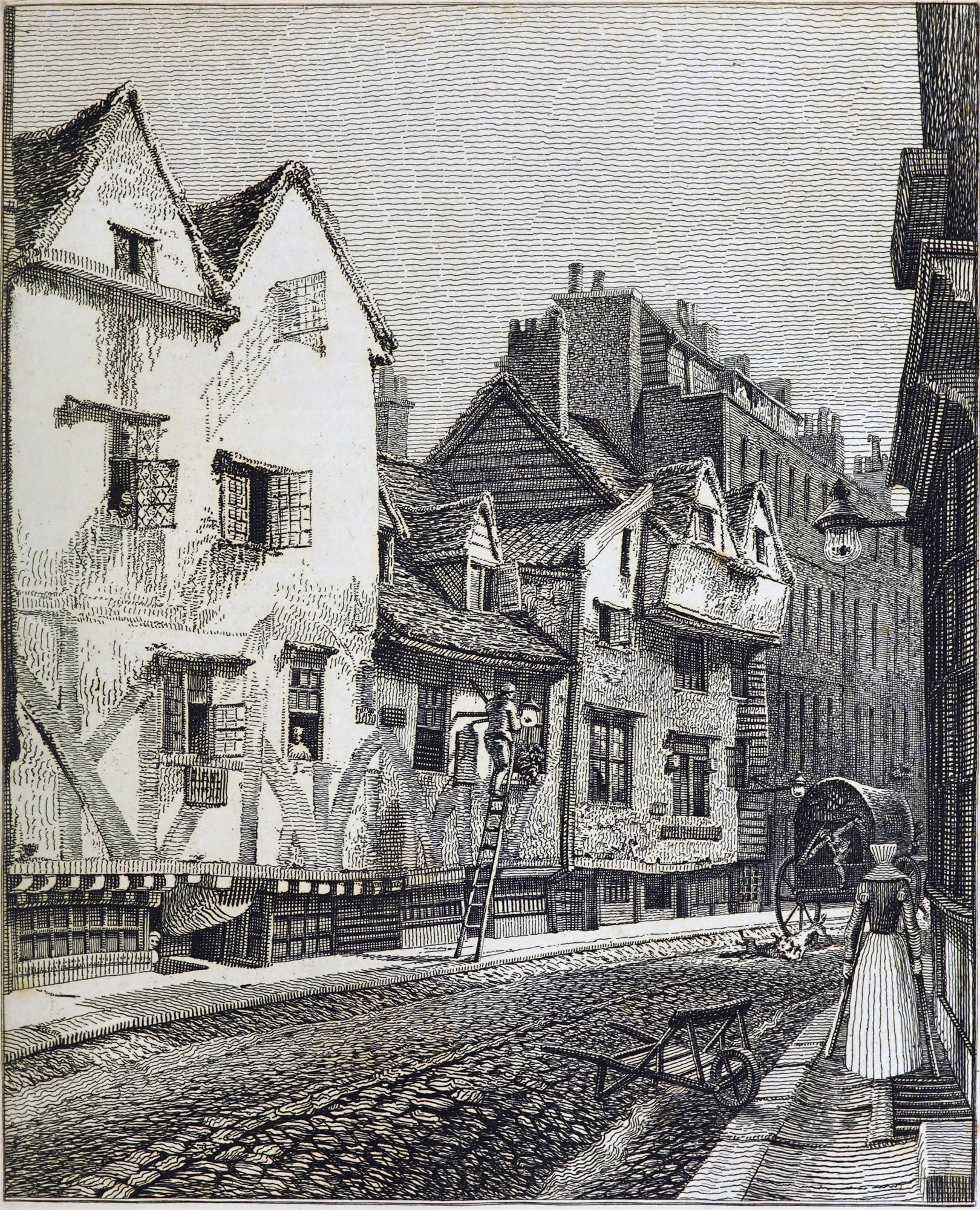
View of Part of Duke Street, West Smithfield
J.T. Smith
1807
Duke Street, drawn in 1807 and published in Ancient Topography of London, by John Thomas Smith (London: J. M'Creery, published and sold by the proprietor, John Thomas Smith, etc., 1815) (facing page 54).
The houses represented in the opposite plate display a ruder mode of domestic building, and, perhaps, a greater quantity of heavy timber, than any now remaining in London. The walls are lath and plaister; the timber, oak and chesnut; the rooms are small, with low ceilings; their staircases perpendicular and narrow; the windows irregular in their forms, and ill-placed.
I could not discover that these houses had ever been decorated. Fortunately there is the date 1599 cut in one of the beams at the back of the fourth house, by the order of the late Rev. Dr. Edwards, vicar of St. Bartholomew the Great, to which parish these houses belong. The above date was discovered by the Doctor upon a board taken from one of the houses when they were repaired, about twenty-five years ago. The floors of the shops are nearly two feet lower than the present street; and one of the inhabitants informed me, that formerly they were ascended by steps, and that he believes the ground to have been raised about four feet. Mr. Johnson who, at present, inhabits the fourth of these houses, has assured me that, to a certainty, there is chesnut in his house, and as he is a turner of every sort of wood, his opinion is of much weight.
This street was formerly called Duck Lane, as may be seen in many of the old plans and descriptions of London.: In it there stood the Crown Tavern, noticed by Ned Ward the author of "The London Spy," in 1698, who says, speaking of the principal room, "He" (the landlord) "conducted us into a large stately room, where, at first entrance, I discerned the master strokes of the famed Fuller's pencil, the whole room being painted with that commanding hand, that his dead figures appeared with such lively majesty that they begot reverence in us, the spectators, towards the awful shadows; our eyes were so delighted with this noble entertainment, that every glance gave new life to our weary senses." The pictures in this room consisted of the "Nine Muses, Pallas, Mars, Ajax, Ulysses, &c." which must have been painted before 1672, as Isaac Fuller, the painter, died in that year.
"Mr. Edward Ward, the author of the London Spy, and many doggerel poems, coarse it is true, but not devoid of humour and pleasantry, kept a public-house in Clerkenwell, and there sold ale of his own brewing. From thence he removed to a house in an alley « on the West side of Moorfields, between the place called Little Moorfields, and the end of Chiswell Street, and sold the same kind of liquor. His house, as we are given to understand by the notes on the Dunciad, was for a time the great resort of high churchmen."—See Sir John Hawkins's History of Music, Vol. v. p. 73.
The remarkable figure with crutches represents the malignant Ann Siggs, before mentioned, praise-worthy for nothing but her cleanliness, a rare quality in a beggar.
Slander, from whose sting the most amiable persons are not invulnerable, tempted this woman to spread the report of her being the sister of Mrs. Siddons. I collect, from a truly interesting work of singular London characters, drawn with great truth, and published by my worthy friend, Mr. James Parry, Seal Engraver, Wells Street, Oxford Street, that she was the daughter of an industrious poor man, a leather breeches maker, of Dorking, in Surrey. (54)
This image is in the public domain.